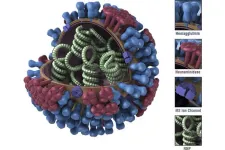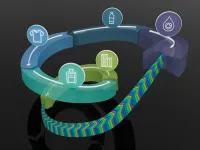(Press-News.org) Weather-related power outages in the United States have become nearly twice as common in the last ten years compared to the previous decade. These outages, which can last most of a day, are more than an inconvenience: lack of power and related indoor temperature discomfort can exacerbate health conditions; lack of power also endangers the lives of people who are reliant on electricity-powered medical devices and/or elevators.
A new study led environmental health scientists at Columbia University Mailman School of Public Health and the University of Washington examines the link between various types of extreme weather and outages in New York State between 2017 and 2020 and who is most at risk in both urban and rural settings. They find that certain regions, including eastern Queens, upper Manhattan and the Bronx, the Hudson Valley, and Adirondack regions were more burdened with severe weather-driven outages (see a list of the most impacted areas below).
The study in the journal PLOS Climate is among the first to provide a granular understanding of severe weather-driven outages and their community impacts.
“The vulnerability of the power grid to severe weather events is a critical issue as climate change is expected to increase extreme events, which can damage components of the power grid and lead to power outages,” says study first author Nina M. Flores, a doctoral student at Columbia Mailman School. “Understanding what communities are most affected by these outages can help policymakers shore up the electrical system and prepare contingency plans.”
In their study, Flores and colleagues paired hourly power outage data in 1,865 electrical power operating localities throughout New York State with CDC Social Vulnerability Index, and hourly weather data from 2017 through 2020. They found that 40 percent of all outages co-occurred with severe weather. Dual extreme heat/precipitation and extreme precipitation/wind were the most likely to precede outages while extreme precipitation/wind and extreme wind alone led to the longest outage durations.
The average duration of outages in rural regions was 12.5 hours compared to 18.5 hours in cities other than New York City and 20.2 hours in the New York City area.
In New York City, heat-, precipitation-, and wind-driven outages disproportionately impacted vulnerable communities; on average, the duration of precipitation-driven outages was highest in neighborhoods with the highest social vulnerability. Likewise, in rural New York State, on average, the duration of precipitation- and snow-driven outages were higher in localities with higher social vulnerability.
The most impacted New York locales by type and the total number outage events driven by severe weather, 2017-2020:
New York City neighborhoods: Jamaica (Queens), 147; Flushing (Queens), 138; Richmond Hills (Queens), 104; Woodrow (Staten Island), 98; Wainwright (Staten Island), 94.
Cities other than New York City: Lewisboro (Westchester), 48; Flower Hill (Nassau), 42; Putnam Valley (Putnam), 39; Boston (Erie), 38; Cornwall (Orange), 38.
Rural New York: Mill Neck (Nassau), 30; Long Lake (Hamilton), 29; Morehouse (Hamilton), 29; North Salem (Westchester), 28; Pound Ridge (Westchester), 28.
Ensuring uninterrupted electricity will take a variety of policy changes. For example, the researchers write that New York City may prioritize improvements that increase reliability during extreme precipitation, as extreme precipitation-driven outages were both more frequent and longer in vulnerable regions. Programs to subsidize cleaner and safer solar-powered battery backup power sources are also needed—especially for people who depend on electricity for medical reasons. (Gas-powered backup generators put people at risk of carbon monoxide poisoning.)
Senior author Joan A. Casey, assistant professor of environmental and occupational health sciences at the University of Washington, says: “Climate change necessitates that we address power outages. In addition, our transition to clean energy will slow climate change but make more people reliant on electricity for heating, cooking, and transit. We should be mindful that this can increase the number of individuals vulnerable to adverse health impacts due to power loss, and also further burden vulnerable communities that our study already identified. Moving forward equitably will require targeted improvements in these regions.”
Co-authors include Alex J. Northrop, Vivian Do, Milo Gordon, Kara E. Rudolph, and Diana Hernández at Columbia Mailman and Yazhou “Leo” Jiang at Clarkson University.
Support for the research was provided by the National Institute for Environmental Health Sciences (NIEHS) (grants ES009089, ES007033, ES007322-22).
The authors have no conflicts to report.
END
These communities are most vulnerable to weather-related power outages in New York State
2024-05-01
ELSE PRESS RELEASES FROM THIS DATE:
New strategy could lead to universal, long-lasting flu shot
2024-05-01
DURHAM, N.C. -- Duke researchers have opened a new avenue in the attack against influenza viruses by creating a vaccine that encourages the immune system to target a portion of the virus surface that is less variable.
Their approach worked well in experiments with mice and ferrets and may lead to more broadly-protective influenza vaccines and less reliance on an annual shot tailored to that year’s versions of the virus. Even with vaccines, influenza kills about a half-million people each year around the world.
This new vaccine approach, described May 1 in the journal Science Translational ...
Mystery behind huge opening in Antarctic sea ice solved
2024-05-01
EMBARGOED: Not for Release Until 14:00 U.S. Eastern Time (19:00 UK Time) on Wednesday, 01 May 2024
Mystery behind huge opening in Antarctic sea ice solved
Researchers have discovered the missing piece of the puzzle behind a rare opening in the sea ice around Antarctica, which was nearly twice the size of Wales and occurred during the winters of 2016 and 2017.
A study published today [1 May 2024] in Science Advances reveals a key process that had eluded scientists as to how the opening, called a polynya, was able to form and persist for ...
Brain imaging study reveals connections critical to human consciousness
2024-05-01
Human consciousness requires arousal (i.e., wakefulness) and awareness
Brain imaging studies over the last decade have produced connectivity maps of the cortical networks that sustain awareness, but maps of the subcortical networks that sustain wakefulness are lacking, due to the small size and anatomic complexity of subcortical structures such as the brainstem
In a magnetic resonance imaging (MRI) study that integrated high-resolution structural and functional connectivity data, researchers mapped a subcortical brain network that is believed to integrate arousal and awareness in human consciousness
In a paper titled, “Multimodal ...
Do earthquake hazard maps predict higher shaking than actually occurred?
2024-05-01
A new study by Northwestern University researchers and coworkers explains a puzzling problem with maps of future earthquake shaking used to design earthquake-resistant buildings.
Although seismologists have been making these maps for about 50 years, they know very little about how well they actually forecast shaking, because large damaging earthquakes are infrequent in any area.
To learn more, the Northwestern research team compiled shaking data from past earthquakes. These include CHIMP (California Historical Intensity Mapping Project) ...
Science has an AI problem. This group says they can fix it.
2024-05-01
AI holds the potential to help doctors find early markers of disease and policymakers to avoid decisions that lead to war. But a growing body of evidence has revealed deep flaws in how machine learning is used in science, a problem that has swept through dozens of fields and implicated thousands of erroneous papers.
Now an interdisciplinary team of 19 researchers, led by Princeton University computer scientists Arvind Narayanan and Sayash Kapoor, has published guidelines for the responsible use of machine learning in science.
“When we graduate from traditional statistical methods to machine learning methods, there are a vastly ...
Study shows a tale of two social media platforms for Donald Trump
2024-05-01
BUFFALO, N.Y. – Truth Social was more effective at driving news attention toward Donald Trump during the 2022 midterm election cycle than Twitter (now known as X) was during the 2016 primary election season, a pattern driven mostly by partisan media on the left and the right, according to a new paper by a University at Buffalo communication researcher.
But that success had limits.
Journalists covered Trump’s social media use differently during those times and across those platforms, directly embedding his Truth Social posts into their stories far less frequently than was the case with his tweets in 2016.
The findings published in the Journal of Information ...
Roadmap to close the carbon cycle
2024-05-01
RICHLAND, Wash.--A major approach to achieving net-zero carbon emissions relies on converting various parts of the economy, such as personal vehicles and heating, to run via electricity generated from renewable sources. But carbon cannot be removed from all parts of society. Plastics, ubiquitous in the modern world, cannot be decarbonized because they are made of carbon-based molecules.
Led by chemist Wendy Shaw of Pacific Northwest National Laboratory (PNNL), a multi-institutional effort has produced a new roadmap to reducing emissions in hard-to-electrify segments of the economy. The multifaceted approach includes developing non-carbon fuels, ...
The Protein Society announces its 2024 award recipients
2024-05-01
LOS ANGELES, CA – The Protein Society, the premier international society dedicated to supporting protein research, announces the winners of the 2024 Protein Society Awards, which will be conferred at the 38th Anniversary Symposium, July 23 – 26, 2024, in Vancouver, Canada. Plenary talks from select award recipients will take place throughout the 3.5-day event. The winners’ scientific accomplishments, described by their nominators below, demonstrate their lasting impact on protein science.
The ...
UMSOM preclinical study finds novel stem cell therapy boosts neural repair after cardiac arrest
2024-05-01
Researchers at the University of Maryland School of Medicine (UMSOM) have identified an innovation in stem cell therapy to regenerate neural cells in the brain after cardiac arrest in an animal model. The study led by Xiaofeng Jia, BM, MS, PhD, FCCM, Professor of Neurosurgery, found that the application of modified sugar molecules on human neural stem cells improved the likelihood of the therapy's success. The application of these sugar molecules both enhanced the stem cells' proliferation and their transition into neurons to help repair critical connections in the brain. The finding could eventually lead to improved recovery of patients ...
With huge patient dataset, AI accurately predicts treatment outcomes
2024-05-01
COLUMBUS, Ohio – Scientists have designed a new artificial intelligence model that emulates randomized clinical trials at determining the treatment options most effective at preventing stroke in people with heart disease.
The model was front-loaded with de-identified data on millions of patients gleaned from health care claims information submitted by employers, health plans and hospitals – a foundation model strategy similar to that of generative AI tools like ChatGPT.
By pre-training the model on a huge cache of general ...


